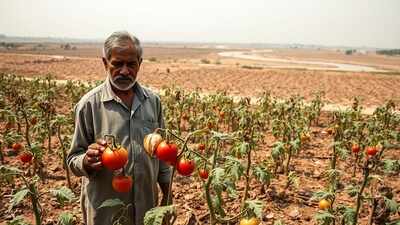ARTICLE AD BOX

BATHINDA: Climate Trends, a research consultancy, in a new study has found how climate change is directly linked to crop losses, and India’ rising food inflation. The research shows how extreme heatwaves and erratic rainfall have severely impacted tomato, onion, and potato (TOP) production over the past five years—pushing up prices of these kitchen staples and driving food inflation to alarming levels.Climate change is intensifying extreme weather events, disrupting food systems, and threatening price stability—especially in India’s vegetable markets. Short-duration, perishable crops like tomatoes, onions, and potatoes are highly sensitive to sudden weather shocks, exhibit sharp price volatility and are major drivers of food and headline inflation. A study by the Reserve Bank of India suggests that on an average, rainfall changes raise vegetable inflation by about 1.24 percentage points, while temperature changes increase it by around 1.30 points.
Extreme weather disrupts supply, damages crop in the field and storage, and worsens post-harvest losses, causing sharp price spikes in TOP vegetables. Their concentrated production in a few states make their prices highly volatile, found the analysis. Food inflation, which had eased post-2014 due to improved supply, spiked in 2019-20 owing to unseasonal and excessive rains. Key triggers included kharif onion crop damage in Maharashtra, Karnataka and Madhya Pradesh (Oct–Nov 2019), and rainfall and cyclone induced potato crop losses in UP and West Bengal (Mar–May 2020).
The rising trend continued further in 2020-21 amid pandemic disruptions. It briefly moderated in 2021-22 but climbed again due to post-pandemic demand and the Russia-Ukraine war.
Just as conditions began to stabilize, erratic weather in 2023-24 triggered new supply shocks, especially in vegetables, keeping inflation high.Heavy rains in Himachal Pradesh and Karnataka caused a 10.9% and 12.9% production decline of tomatoes, pushing prices up to Rs 67/kg from Rs 18 in June 2023.
Unseasonal rain and hailstorms in Maharashtra led to a 28.5% production drop on onions in 2023; prices rose to Rs 39/kg in November 2023. Unseasonal rain in West Bengal and frost in Uttar Pradesh reduced production of Potatoes by 7% in 2023-24, keeping prices elevated throughout 2024.
2024 marked the hottest year on record, with heatwaves and erratic rains driving prices of all three vegetables above historical levels.
Consumer food price inflation peaked at 11.5% in July 2023 and 10.87% in October 2024. Vegetable inflation spiked to 37% in July 2023 and 42% in October 2024. Small and marginal farmers, who dominate vegetable supply, face disproportionate losses due to lack of safeguards, storage, and transport infrastructure. The study has recommended promoting climate-resilient crop varieties and protected cultivation (greenhouses for tomatoes). Improve supply chain resilience through cold storage, refrigerated transport, and better warehousing. Develop weather-informed price forecasting and timely advisories. Strengthen social protection (index-linked insurance, nutrition safety nets) to protect vulnerable households.
Encourage cluster farming and collective action to reduce post-harvest losses and market shocks.



.png)
.png)
.png)
















 2 days ago
4
2 days ago
4








 English (US) ·
English (US) ·